Introduction: A Melodic Comeback
In the ever-evolving landscape of digital streaming, the clash between artistic integrity and corporate influence often takes center stage. Two years ago, music legend Neil Young made headlines when he took a stand against Spotify, pulling his catalog from the platform in protest against content hosted by podcaster Joe Rogan. However, in a surprising turn of events, Young recently announced his return to Spotify, signaling a notable shift in his stance. This decision not only reignites discussions about the intersection of art and commerce but also prompts reflection on the power dynamics within the music industry. Let’s delve into the intricacies of this resurgence and its broader implications.
The Exit: A Defiant Departure
Young’s departure from Spotify in 2022 sent shockwaves through the music world. Citing concerns over misinformation and controversial content featured on Joe Rogan’s podcast, he chose to remove his extensive discography from the platform. This move was emblematic of a larger movement among artists who seek to hold streaming services accountable for the content they promote. By taking a principled stand, Young demonstrated his unwavering commitment to his values, even at the expense of widespread accessibility to his music.
The Silence: Echoes of Absence
In the wake of Young’s departure, Spotify faced scrutiny regarding its content moderation policies and the influence of high-profile figures like Joe Rogan. While some applauded Young’s bold stance, others lamented the absence of his timeless tunes from their playlists. The void left by his departure served as a poignant reminder of the complex relationship between artists and the platforms that distribute their work. Yet, amidst the silence, discussions persisted, highlighting the broader implications of artists’ rights in the digital age.
The Revival: A Surprising Reconciliation
Just as the music world had grown accustomed to the absence of Neil Young’s catalog on Spotify, the announcement of his return sent ripples of intrigue throughout the industry. Young’s decision to rejoin the platform marks a significant shift in his approach, one that signals a willingness to engage in dialogue and perhaps seek alternative avenues for effecting change. While the specifics of his decision remain somewhat elusive, it undoubtedly serves as a catalyst for renewed conversation surrounding the complexities of artistic expression and digital distribution.
The Controversy: Discordant Discourse
Unsurprisingly, Young’s decision to return to Spotify has reignited debates among fans, critics, and industry insiders alike. Some view his return as a pragmatic move aimed at reaching a wider audience and reclaiming control over his narrative within the streaming landscape. Others, however, question the sincerity of his stance, suggesting that his return may undermine the principles he once vehemently defended. Amidst the discordant discourse, one thing remains clear: the intersection of art and commerce continues to be a contentious battleground where compromises are often met with skepticism.
The Evolution: Harmonizing Ideals and Realities
As Neil Young navigates the complex terrain of digital distribution, his journey reflects the evolving nature of artistic expression in the modern era. The tension between upholding artistic integrity and engaging with mainstream platforms underscores the inherent challenges faced by creators in an increasingly interconnected world. While Young’s decision may not satisfy everyone, it serves as a reminder that navigating the delicate balance between ideals and realities requires a nuanced understanding of the forces at play.
The Impact: Amplifying Perspectives
Beyond the individual realm of Neil Young’s music, his return to Spotify holds broader implications for the music industry as a whole. It prompts reflection on the power dynamics between artists, streaming platforms, and the audiences they serve. Moreover, it underscores the need for ongoing dialogue and collaboration to address the ethical, cultural, and artistic considerations inherent in the digital age. By amplifying diverse perspectives and engaging in constructive discourse, stakeholders can work towards a more equitable and sustainable future for music distribution.
The Resolution: A Harmonious Future?
As Neil Young’s catalog once again graces the digital shelves of Spotify, the music world stands at a crossroads, poised between tradition and innovation, principle and pragmatism. While the resolution to this ongoing saga remains uncertain, one thing is clear: the conversation surrounding the intersection of art, technology, and ethics will continue to evolve. Whether through individual gestures or collective movements, the quest for harmony in the digital age remains an ever-present refrain.
Conclusion: The Rhythm of Renewal
Neil Young’s return to Spotify serves as a compelling chapter in the ongoing narrative of music in the digital age. From his defiant departure to his surprising reconciliation, his journey encapsulates the complexities and contradictions inherent in the intersection of art and commerce. As the industry grapples with questions of censorship, accountability, and artistic freedom, Young’s decision prompts introspection and dialogue, challenging us to confront the discordant notes of the present in pursuit of a more harmonious future.
